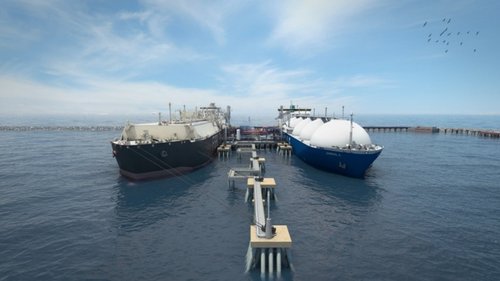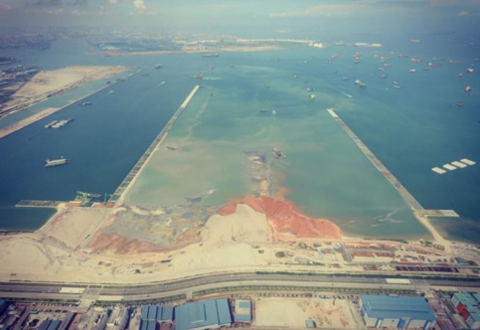
Montevideo LNG Terminal
Gas Sayago S.A. plans the development of a re-gasification terminal close to Punta Sayago, west of Montevideo in the estuary of the Rio de la Plata (Uruguay). Appointed by GDF Suez Energy International, IMDC provided advice regarding marine works and assistance in designing the marine infrastructure following a probabilistic level III approach. Together with Tractebel Engineering, IMDC acted as Owner’s Engineer for the management of the EPC Contract (engineering, procurement, construction, pre-commission and commissioning), including environmental management and follow-up of the EPC Contractor activities.

IMDC was involved in the project from the prequalification phase onward. Together with Tractebel Engineering (TE), IMDC acted as Owner’s Engineer to secure services for the management of the EPC Contract for the construction of the project infrastructure (marine works and LNG related infrastructure) and the LNG process topside and to follow up the EPC Contractor activities (engineering, procurement, construction, pre-commissioning, and commissioning assistance) related to the project.
In project execution phase IMDC is commissioned with providing technical support and site management services, on Owner’s Engineer side, for the marine works and related infrastructure, comprising dredging works, soil replacement, jetty construction, geotechnical matters and environmental and permitting support. IMDC provided both back-office support services and site management and coordination services with respect to Contractor’s engineering, procurement, construction as well as commissioning for the marine works.
The project also included the investigation of necessary aids to navigation for the terminal according to International guidelines and regulation.
In addition the project included amongst others following key activities for IMDC:
In situ measurements
Salinity and turbidity measurements were required as input for the design of the FSRU (Floating Storage Regasification Unit). Therefore, an urgent campaign was set up, in which we measured for 14 days in location at and nearby the project area. In addition, to understand the fluctuations of these parameters over longer periods, these measurements continued on a bi-weekly basis.
To follow up possible sedimentation during the backfilling works, which can endanger the geotechnical stability of the breakwater, IMDC has also performed in situ density measurements. Hence, when sedimentation is detected, measures can be taken in time.
Apart from the direct added value of the measurements, they are also used to calibrate the numerical models used to predict sedimentation in for example the berth pocket and to design measures to avoid such.
Numerical modelling
Wave agitation models have been used to optimize the breakwater layout: the total breakwater length has been reduced with 800 m or 35%, still respecting the project criteria.
As input for the probabilistic design, a detailed transformation of the offshore wave conditions was required. A combination of SWAN and the agitation models has been used, together with a thorough statistical analysis.
A hydrodynamic 3D model has been set up to determine the impact of the breakwater on the current conditions. This model is the basis for the sedimentation model that was set up to predict annual sedimentation rates in the berth pocket.
Further on, coliform bacteria modelling was requested by the client, and we also needed to model the impact of (deeper) dredging works in borrow area: would those have an impact on wave and current conditions nearby the Uruguay shoreline?
Operational Forecast System
An operational forecast system was set up to provide a complete forecast to site including wind, waves, water levels and currents. The IMDC operational forecasting system processed automatically all the input, ran the model trains and processed the simulation results. The end result was an operational forecast of the expected waves, currents, water levels and wind for the following 5 days.
Design aspects
In an early project stage, we specified project requirements, the applicable design principles, criteria, codes and standards and design requirements to be taken into account during the detailed design of the breakwater and jetty. Later on, we were actively involved in the breakwater design. For the hydraulic design, we set up a test program and followed up the physical model tests.
We coordinated the detailed design to take into account future scour, propeller action and interaction with the geotechnical design. For the geotechnical design, we performed detailed calculations to optimize the soil improvement.
To further understand the quality of the backfill material, we organized our own laboratory tests. Acceptance criteria were also set up for the CPT verification campaign. Finally, we worked out a level III probabilistic design for the hydraulic breakwater’s stability, starting from our detailed numerical wave modelling. Objective of this study was to determine the probability of failure, which needed to be less than 1% over the project’s lifetime of 50 years.
Follow up of works
Activities on site are not only performed on land: our IMDC colleagues on site and dedicated Client representatives permanently witness the offshore works. For example, dredging works are followed up to verify Contractor is respecting all permits. The backfill works were followed up to get insight in the available material at the borrow location, and for similar reasons a vibrocore campaign was followed up.
Data
- Client: GDF Suez
- Start: 2012
- Completion: 2015



